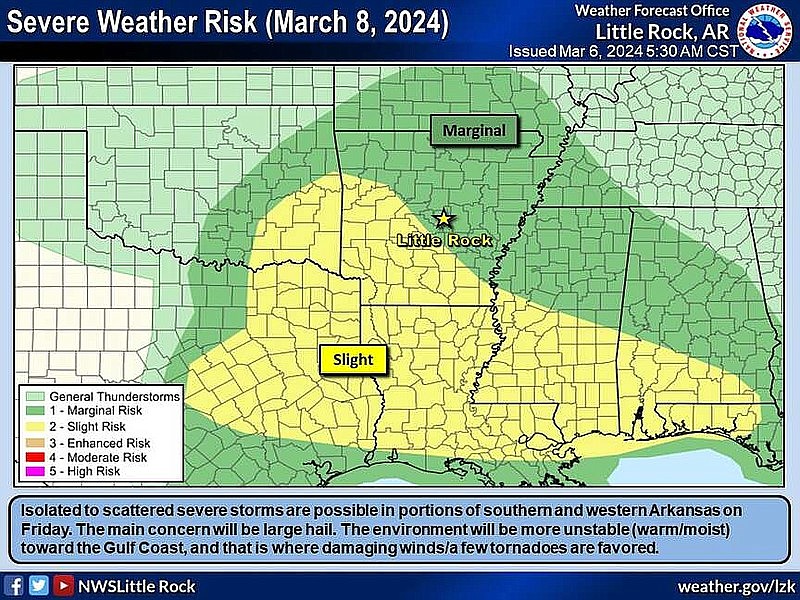Much of Arkansas could see storms featuring large hail or strong winds on Thursday and Friday, the National Weather Service said.
"Scattered to numerous showers and thunderstorms are expected Thursday and Friday. Some storms could be severe on Friday in parts of southern and western Arkansas," the weather service said in a post on X Wednesday morning.
Most of southern and eastern Arkansas is at a slight risk for severe weather, while the rest of the state is at a marginal risk for severe weather, the weather service said in a hazardous weather briefing on Wednesday.
A marginal risk for severe weather means that isolated severe storms are possible, the weather service said in a post on X earlier this month. A slight risk is defined as conditions where scattered severe storms are possible.
Dylan Cooper, a meteorologist with the National Weather Service office in North Little Rock, said the largest concern with the upcoming storms is hail.
"There is a chance that these storms produce large hail, and damaging winds aren't out of the question," Cooper said Wednesday morning. "The potential for tornadoes in the state is very low but it is never really zero.
"It's been almost a year since the last big tornado, so it is reasonable for people to be concerned," he said. "So there might be some strong wind on Thursday and Friday, but none of the spinning variety."
Cooper said there is not enough instability in the area that would make these storms a widespread severe weather event.
"If there was more instability or storm fuel, I would be worried, but most of the severe weather threats will be west or south of us," the forecaster said.
Little Rock is unlikely to see any strong storms on Thursday, but there is a small chance for them to form in the morning, he said. On Friday, the metro area could see some storms in the late afternoon to evening.
"It is a slow-moving storm, so we will likely see repeated waves of showers and storms over the state, instead of just one big storm that we're looking at," Cooper said.
The forecaster said the rainfall for the event was harder to describe. "Most areas statewide are looking to see an inch to an inch and a half of rain," he said. "Some areas like the Ozarks might see closer to two or three inches. None of this sounds like a lot of rain by Arkansas standards."
Cooper said Arkansans should still be cautious because, on Tuesday, rain caused Richland Creek near Witts Springs and the Buffalo River to rise.
Richland Creek rose nearly 10 feet in just under three hours, a post on X from the National Weather Service said Tuesday morning.
"And the Buffalo River rose several feet as well," he said. "That's due to reports of four to eight inches of rain falling in the southern parts of Newton and Searcy counties."
The forecaster said those rainfall estimates were radar-reported, as the weather service didn't have gauges in the area forecast to have received the heaviest rainfall.
"It's important to consider that, while it isn't a lot of rain, sometimes even a modest amount is enough to make rivers rise and this is the time of year that a lot of people start wanting to be out near the water or on the water," he said.
Cooper said that, while trees are budding, they are not fully awake and growing and therefore are not yet starting to pull a lot of water from the ground.
"April showers bring May flowers, but March showers bring flash floods," he said.
Arkansans should plan for a wet end to their work week and keep an eye on forecasts if they plan to get out in nature this weekend, he said.
BURN BANS
As of Wednesday morning, only eight counties in Arkansas had a burn ban in place, according to a map published by the Arkansas Department of Agriculture.
The eight counties are Lincoln, Lafayette, Nevada, Sharp, Searcy, Carroll, Madison and Washington.
Much of the state is at a moderate risk for wildfire danger, including Pulaski County, another map from the department showed. Parts of northeast and southwest Arkansas were at a high risk.
